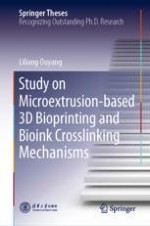2019 | Buch
Über dieses Buch
This book presents a comprehensive study on microextrusion-based 3D bioprinting technologies for bioinks with various crosslinking mechanisms, chiefly focusing on the bioprinting process and bioink properties to provide readers with a better understanding of this state-of-the-art technology. Further, it summarizes a number of general criteria and research routes for microextrusion-based 3D bioprinting using three experimental studies based on shear-thinning, thermo-sensitive and non-viscous hydrogel bioinks. The book also presents sample applications in the areas of stem cells and cell matrix interaction.
The book highlights pioneering results in the development of bioprinting technologies and bioinks, which were published in high-quality journals such as Advanced Materials, Biofabrication and ACS Biomaterials Science & Engineering. These include an in-situ crosslinking strategy that overcomes the viscosity limits for bioinks, which is virtually impossible using conventional strategies, and can be generalized for other bioink formulations.
Anzeige
